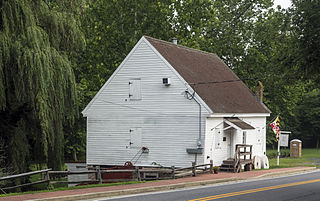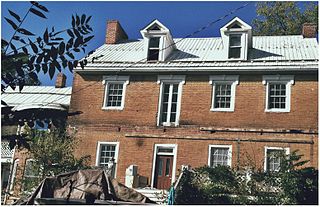
Busti is a town in Chautauqua County, New York, United States. The population was 7,351 at the 2010 census. The town is named after Paul Busti, an official of the Holland Land Company, but its pronunciation uses a long i sound at the end, a frequent alteration in the names of several upstate New York towns. It has frequently been noted on lists of unusual place names.

Ellicott is a town in Chautauqua County, New York, United States. The population was 8,714 at the 2010 census. The town is named after Joseph Ellicott, an agent of the Holland Land Company.

Jamestown is a city in southern Chautauqua County, New York, United States. The population was 28,712 at the 2020 census. Situated between Lake Erie to the north and the Allegheny National Forest to the south, Jamestown is the largest population center in the county. Nearby Chautauqua Lake is a freshwater resource used by fishermen, boaters, and naturalists.

Mayville is a village in Chautauqua County, New York, United States. The population was 1,711 at the 2010 census, 2.7% less than in the 2000 census. Mayville is in the town of Chautauqua and is the county seat of Chautauqua County. The village and town offices share a building on Main Street, directly across from the Chautauqua County courthouse.

Jericho is a town in Chittenden County, Vermont. As of the 2020 census, the population was 5,104. The town was named after the ancient city of Jericho.

The Chautauqua Institution is a 501(c)(3) nonprofit education center and summer resort for adults and youth located on 2,070 acres (8.4 km2) in Chautauqua, New York, 17 miles (27 km) northwest of Jamestown in the southwestern part of New York State. Established in 1874, the institution was the home of and provided the impetus for the Chautauqua movement that became popular in the US in the late 19th and early 20th centuries. The Chautauqua Institution Historic District is listed on the National Register of Historic Places and was further designated a National Historic Landmark.

Forestville is a ghost town in section 13 of Forestville Township in Fillmore County, Minnesota, United States. The nearest communities are Wykoff, to the northwest, and Preston, to the northeast.

Bois d'ArcBOH-dark is an unincorporated community in Butler County, Kansas, United States. It is located about six miles southeast of Augusta in Bloomington Township.

Kirby's Mill is a historic grist mill in Medford, Burlington County, New Jersey, United States. Originally known as Haines Mill, it was built in 1778 by Isaac Haines and partners along the Southwest Branch of Rancocas Creek. It was the last commercial operating mill in New Jersey.

Ashville is a hamlet near the junction of state routes 474 and 394, on the line between the towns of North Harmony and Busti in Chautauqua County, New York, United States. It is the location of the Smith Bly House, listed on the National Register of Historic Places in 1974. The hamlet is located at an elevation of 1358 ft above sea level.

The Gibbs Farm is a museum in Falcon Heights, Minnesota, United States. The site was once the farmstead of Heman Gibbs and Jane DeBow, first built in 1854; the existing farmhouse includes the small, original cabin. The museum seeks to educate visitors on the lives of 19th-century Minnesota pioneers and the Dakota people who lived in southern Minnesota before the arrival of Europeans.

The Wye Mill is the oldest continuously operated grist mill in the United States, located at Wye Mills, Queen Anne's County and Talbot County, Maryland, United States. It is the earliest industrial site on the Eastern Shore in continuous use; dating to the late 17th century. It is a wood-frame, water-powered grist mill, with a 19th-century 26 HP 10-foot-diameter (3.0 m) Fitz steel overshot wheel. The mill retains nearly all of its late-18th-century equipment. The Wye Mill was one of the first grist mills to be automated with the Oliver Evans process, which is still in use today.

Fay-Usborne Mill is a historic grist mill and feed store located at Westfield in Chautauqua County, New York. The original two story, frame feed mill was built in 1899 by James C. Harris. It was purchased in 1913 by John R. Fay who, with his partner Thomas Usborne, expanded the business to include a variety of grain and cereal processing machines.

White Bush, alternately spelled Whitebush, is one of Berkeley County, West Virginia's oldest brick mansions. It was built circa 1781-1785 by Archibald Shearer, who had purchased the entire bend of the Potomac River in this area, about 1,200 acres (4.9 km2). The area at that time was part of Frederick County, Virginia. The property was formerly owned by Lord Fairfax, Thomas Fairfax, 6th Lord Fairfax of Cameron but was confiscated as British property during the American Revolutionary War. A grist and saw mill had been established on the riverfront not far from the mansion by 1785.

The Newlin Mill Complex, also referred to as The Newlin Grist Mill, is a water-powered gristmill on the west branch of Chester Creek near Concordville, Pennsylvania was built in 1704 by Nathaniel and Mary Newlin and operated commercially until 1941. During its three centuries of operation, the mill has been known as the Lower Mill, the Markham Mill, the Seventeen-O-Four Mill and the Concord Flour Mill. In 1958 the mill property was bought by E. Mortimer Newlin, restored and given to the Nicholas Newlin Foundation to use as a historical park. Water power is still used to grind corn meal which is sold on site. The park includes five historical buildings, which were added to the National Register of Historic Places in 1983, and 150 acres (61 ha) of natural woodland.

The Thomas B. Hart House is a Gothic Revival-styled house built in the 1840s in Wauwatosa, Wisconsin. Its most distinctive feature is the many elaborate bargeboards decorated with various patterns. It was added to the National Register of Historic Places in 1985, and is today one of Wauwatosa's oldest surviving houses.

The Gooseville Mill/Grist Mill is a historic mill on the North Branch Milwaukee River in Gooseville, Wisconsin. The mill was built in 1879 to replace an 1855 mill that had burned down. The mill is a small custom mill with board and batten siding and is typical of the custom mills common in Sheboygan County in the 1800s. A Lefel turbine powered the mill, replacing the paddle wheel used in the 1855 mill. A burr mill was used to grind the grain processed at the mill. As of 1984, the mill was still operational and occasionally used as a sawmill.

Busti is a hamlet and census-designated place in the town of Busti in Chautauqua County, New York, United States. The population was 391 at the 2010 census, out of a total population in the town of 7,351.

The Craigie Flour Mill Historical Marker is a wayside rest on Minnesota State Highway 78 in Otter Tail County, Minnesota. The site was designed by landscape architect Arthur R. Nichols and built by the National Youth Administration and the Minnesota Highway Department. The style is National Park Service Rustic architecture.

The Chautauqua Auditorium is a performance hall located in Getzendaner Memorial Park, in Waxahachie, Texas. It was built in 1902 and listed on the National Register of Historic Places on May 3, 1974. The hall seats 2500 and is noted for being an octagonal building. The auditorium hosts performances of the Fort Worth Symphony Orchestra as well as many country music and other shows.























